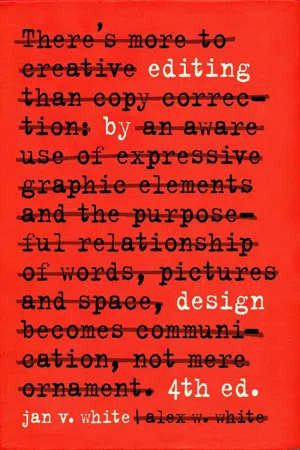
Editing by Design
The Classic Guide to Word-and-Picture Communication for Art Directors, Editors, Designers, and Students
- 224 pages
- English
- ePUB (mobile friendly)
- Available on iOS & Android
Editing by Design
The Classic Guide to Word-and-Picture Communication for Art Directors, Editors, Designers, and Students
About this book
An Industry Classic, Revised for the Modern Age This classic guide to winning readers for designers, art directors, and editors, has been completely updated to be applicable to both online and print publication design. Because it has truths about effective visual communication that transcend ever-changing technology, this book has been in continuous publication since 1974. Revised with the careful attention of widely respected author and professor of graphic design Alex W. White, Editing by Design, Fourth Edition, describes how both word people and design people have the same task: to reveal the true core of each message as plainly and compellingly as possible. It is a book vital to creators of today's online and print media. Readers will find ways to marry content and form, helping story and design to reinforce each other, and create pages that are irresistible. Brimming with three hundred illustrations, chapters cover a wealth of design and editing matters, including:
- How to think about "editing" and "design" as a word person and a design person
- Teamwork and collaboration for story clarity
- Originality and inducement for the reader
- Columns and grids for organization and consistency
- Covers and content listings as tools for deeper reader involvement
- How to use type hierarchy to catch and lure readers
- Representational and non-representational imagery
- Using color as a branding device
Readers will learn how editor-designer collaboration can achieve maximum creative impact through the effective use of words, images, and space. Full of practical examples, this book is equally for designers looking for a deeper understanding of how to design better and for writers and editors wanting to communicate more vividly with the utmost impact, as well as for editorial directors and publishers seeking a competitive advantage.
Frequently asked questions
- Essential is ideal for learners and professionals who enjoy exploring a wide range of subjects. Access the Essential Library with 800,000+ trusted titles and best-sellers across business, personal growth, and the humanities. Includes unlimited reading time and Standard Read Aloud voice.
- Complete: Perfect for advanced learners and researchers needing full, unrestricted access. Unlock 1.4M+ books across hundreds of subjects, including academic and specialized titles. The Complete Plan also includes advanced features like Premium Read Aloud and Research Assistant.
Please note we cannot support devices running on iOS 13 and Android 7 or earlier. Learn more about using the app.
Information

CHAPTER 1
HOW TO THINK ABOUT EDITING










Table of contents
- Front Cover
- Title Page
- Copyright Page
- Contents
- Preface
- Sect 1 The Editing Process
- Sect 2 The Design Process
- Sect 3 Editing Information
- Sect 4 Design Information
- Glossary
- Index
- Colophon
- Bios